Tin Can Middens, Western US
2019
Introduction
Why Look at Rusty Tin Cans?
From the Rocky Mountains west, the wildlands of the United States are typically dry enough that that fairly intact food cans discarded over 100 years ago may be easily found. A glance at the can construction and at the opening technique may provide clues as to when the can was discarded.
Finding Rusty Tin Cans
The cans may be found singly or a few in a cluster where a traveller stopped for just a meal or two, or in piles many feet across near old mines, cow camps, etcetera. Though these contain mostly rusty cans today, they would have originally included every sort of refuse: leftover food, clothes, hardware, tools, glass, etcetera. Much rotted away, and much might be reused once weathering and rotting left the durable parts clean of rotten food, fabric or leather attachments, etcetera. What I'm often looking at is an old garbage dump minus whatever rotted away and whatever was reused by earlier settlers or carried away as souveniers.
Early History of Canning
Canning, either in metal cans or glass jars, seems to have been developed in Europe several times in the late 1700s. Originally, cans would have been made of commonly available wrought iron, perhaps 3⁄16" thick. A hammer and chisel would be required to open such a thick can. These are earlier than any I've seen. When thin sheet metal was available, cans, and can opening, became much more practical. Development of practical openers for each type of can often happened years after the can type became available.
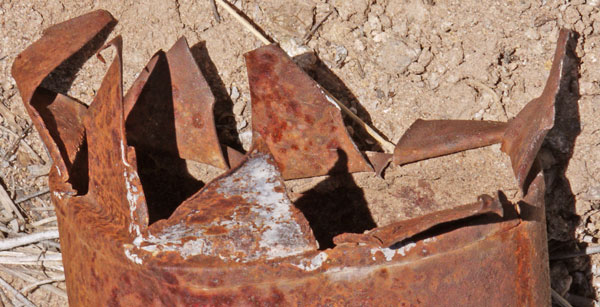
Can Opened by Big, Sturdy Knife
|
|
Modern can ends are crimped (squeezed) onto the can cylinder. In this older can, the shallow cup shaped end of this can slipped over the end of the cylinder, and then was Soldered into place. The whitish residue under the seam at front center is the solder corroding away. The same whitish residue on the pie slice sections is from solder spilled while sealing the can.
See the pie slice section front and center with the white residue. On both sides, the sheet metal has deformed upwards. This indicates that the knife was inside and was pulled upwards through the lid (Uprolled). The front edge of the leftmost leaf is rolled down into the can (Downrolled). This indicates that the knife was forced downwards into the can.
|
Soldered Cans
Soldering
In soldering, two metal parts are joined by melting a different metal (the Solder) and using the solder sort of like glue to hold the pieces together. The solder must be a fairly soft metal which melts at a low enough temperature to not damage the parts of the can or the food. Tin and Lead were the most common metals used for solder in cans. Tin melts at 449.5°F, Lead at 621.4°F, but an eutectic alloy of 61.9% tin and 38.1% lead melts at 361.4°F. The iron or steel sheet metal parts of the can must be absolutely cleaned (via acid flux) and heated a little above the solder melting temperature, but then soldering is easy. One touches a solid bit of solder to the joint, the solder melts and flows by capilary action between touching or closely spaced parts. Both tin and lead are toxic if enough gets into the food, but they are the easiest solder metals to find and use for iron. Tin cans are actually steel, or long ago iron sheet metal: They are refered to as tin cans since they are often coated and soldered with tin.
Modern food cans are not typically soldered. They may be crimped or welded together, and plastic coatings protect the food from absorbing the metals of the cans.
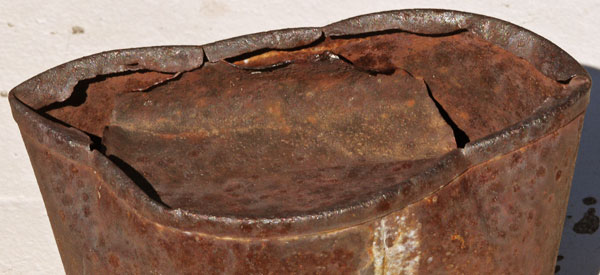
Soldered Can End
|
|
See the solder residue where a flat sheet was rolled and joined to form the cylinder of the can, and also just under the edges of the shallow cup end where it was attached to the cylinder.
|
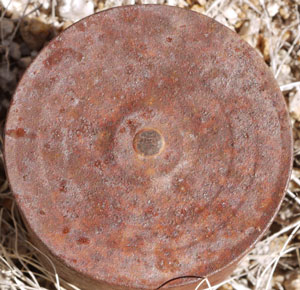
Center Solder Seal
|
The center dot was a hole. After the food was in the can and the ends attached, the can was boiled to sterilize the can and food. Steam escaped through this hole, which finally was solderd shut. |
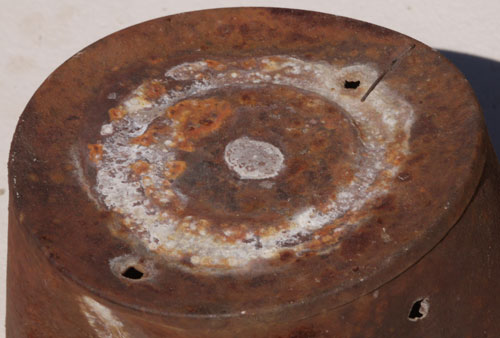
Center Seal, Fill Port, Nail Opened
All Hand Soldered, Vent: 1820 - 1890
|
|
This can was built empty with the two ends attached, but with a large hole to add food in one end. Once the food was added, the ring of solder shown held the second, smaller lid. After the can was boiled, the steam port was soldered shut. Note the two small squarish holes. This can contained only a liquid, and was opened with a hammer and nail.
|
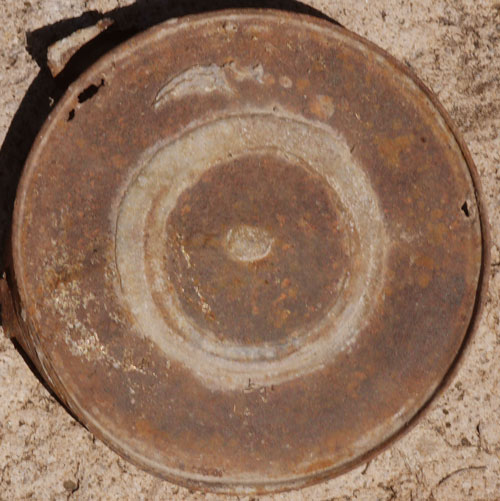
Center Seal, Fill Port
|
|
Previous photos have shown most solder corroded away: In this picture most of the original solder is present. Note the steam vent seal, food port ring, and spilled solder at the top. Note that the end is not a simple shallow cup, but has two walls, both inside and outside the can cylinder, more like a modern crimped can end.
|

Center Seal, Fill Port, Inside View
|
|
The two previous photos showed the fill port and steam vent hole from the outside, this is the view from the inside. No solder is visible. Hopefully, not much would be inside and exposed to the food.
|
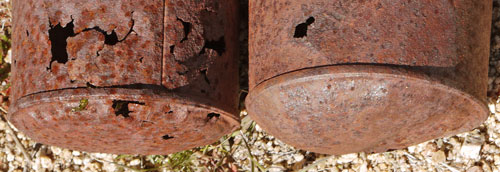
Domed Cans
|
|
When I was young, perhaps the 1970s, people still worried about cans of that were either not properly sterilized before sealing or had some tiny leak. Botulism toxins were most feared, but there were others. Germs would multiply and spoil the food inside. Bulges in the can were one indication the food inside was bad. These two cans were opened all around, and therefore were probably trusted and eaten. I would guess they were probably heated in a campfire too long, until the steam pressure inside popped out the can ends, or that during manufacturing a bit of food clogged the tiny steam port, so the end popped out.
|
Opening Cans
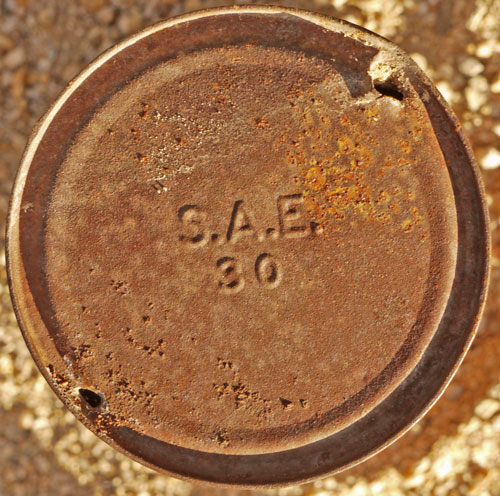
Quart Motor Oil Can
|
|
To the lower left, a small flat bladed screwdriver was forced through the can end and produced a small air hole. The hole edges are regular and rolled down into the can.
To the upper right, the screwdriver was levered around in the hole, producing upturned, downturned, and cracked hole edges, a bent rim, and a larger hole to allow oil to flow quickly.
|
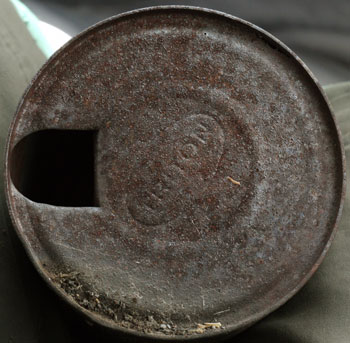
Triton Quart SAE 30 Oil Can
|

Triton Quart SAE 30 Oil Can
|
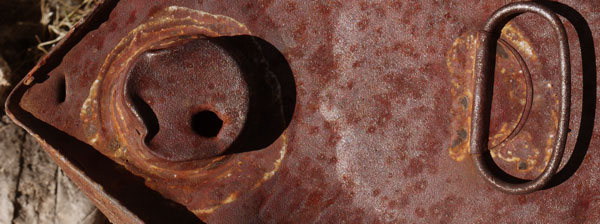
Five Gallon Oil Can
|
|
This type of rectangular steel can is regularly sold containing lubricating oils, heating kerosene, and cooking oils. Solder residues at the handle and screw top show this can is pretty old. There is a flat screwdriver opening at left, a round punch through the threaded closure, and an attempt to rip the top off the threaded closure with piers. A more careful job would allow further use of the screw lid to close the can for storage. The screw lid really only prevents gross spillage: it is not air tight, and an air hole at the opposite corner to prevent glugging as the oil is poured is usually not sealed. Modern equivalent cans often have a small plastic flip top to seal the air vent, and a gasket to seal the screw pour opening.
|

Standard Oil 5 Gallon Can with Fancy Spout
|
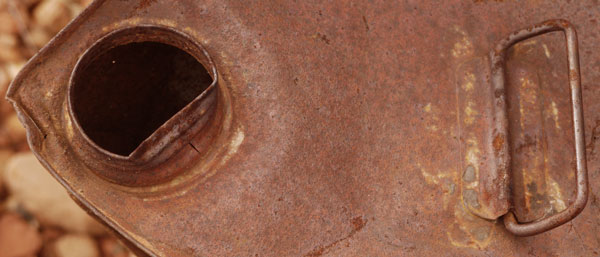
5 Gallon Can
|
|
The circumference of this can is made of two hand soldered sheets - very old. The inside of the threaded spout is machine rolled to seal well against a gasket.
|
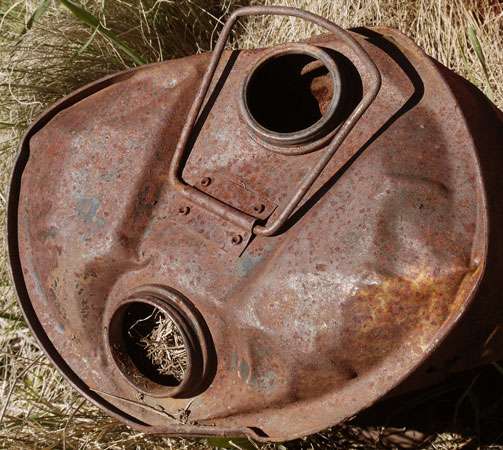
5 Gallon 2 Pour Spout Can
|
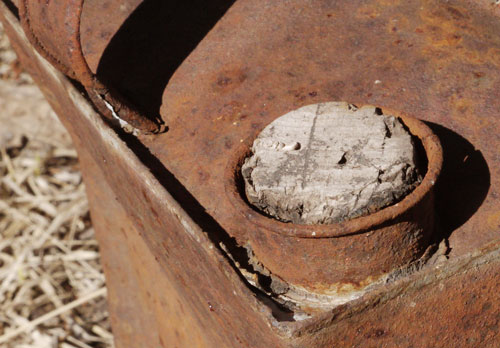
One Gallon Can With Tapered Spout for Cork Closure
Kendrick Mountain
|
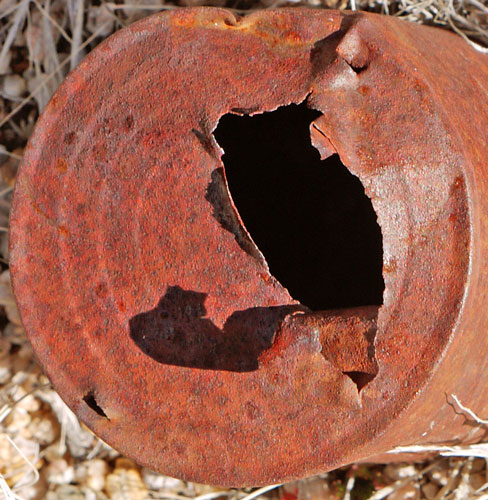
Can, Irregular Opening
|
|
In 1855, Robert Yeates, and in 1858, Ezra Warner each invented claw or lever type can openers. Note that this can does not have the crimped ring that today's can openers grab on to. In today's levering can openers (like a pocket knife, or P38 or P51), a hook grabs below the rim so a blade can be forced down through the lid. The older lever can openers pivoted on the surface of the can end, and pulled a blade up through the lid. Old or new, each time you lever, you cut a fraction of an inch of can lid, repeating levering many times before fully opening a can.
This can was first pierced twice to drink or drain the liquid. These two holes show the shape of the hole first made by the old lever type openers so that the blade could be forced up through the lid. Later a small, irregularly shaped opening was made to extract the solid food, probably by shaking it into a dish.
|
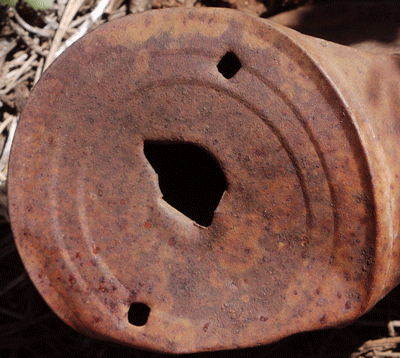
Can with Small Opening and 2 Nail Vents
2 nail holes to drain liquid, then a very small food hole - Something Like Peas or Corn?
|
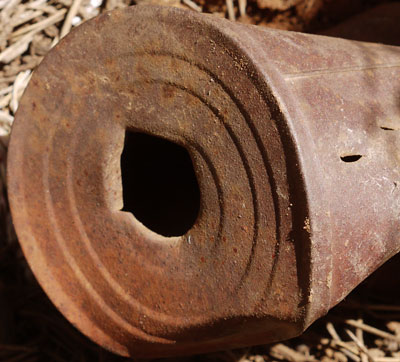
3 Knife Tip Jabs on Can Side and Small Food Hole
|

Can With Irregular Opening, PA, 2017
|
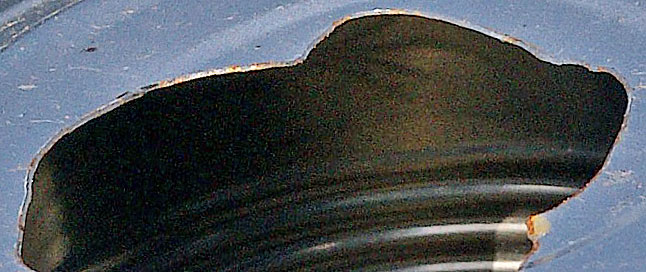
Detail of Irregular Opening
|

Can with Up Rolled Edges
|
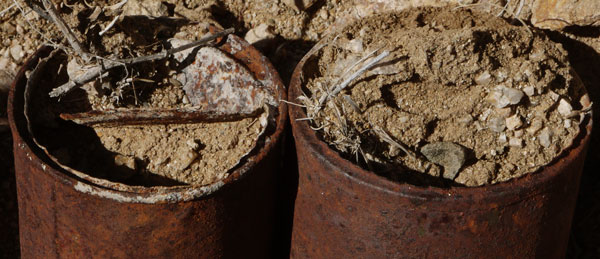
Two Cans with Up Rolled Edges
|
|
Each of these cans was opened by the old, upward cutting lever openers, leaving edges rolled up out of the can. Note that these jagged edges, protruding out of the can, are fairly likely to touch or cut someone handling the can. Both cuts follow a uniform radius, but not right on the can rim like with modern openers. On the left can, with a modern rim profile rising above the lid, the pivot may have ridden along the inside of the rim. The right can, with the older lid style, was likely opened by a tidy person who followed the edge by eye, or the pivot had a step to follow the rim edge. Either way, the large regular opening would make retrieving food a tidier process than with the small irregular opening in the previous illustration.
|
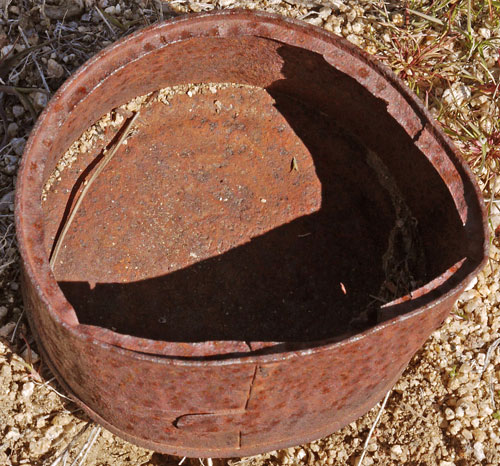
Neat Opening Edge Inside Rim
|
|
At upper right, note the radius of the cut is not perfectly uniform, but overall, the cut is quite neat. The radius is fairly uniform and there is little edge upturning or scalloping. The opener blade may be sharper than normal, or the can material might be less ductile. Note that the can has a strip that can be removed from the sidewall with a key, and the user chose to open the top anyway.
|
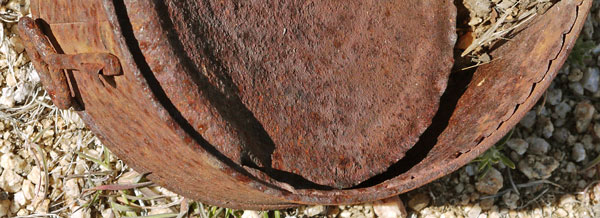
Can, Scalloped Edge
|
|
This can was also top opened even though the key and strip could have been used. The opener was a modern, down cutting lever type. There is a clear scallop for each time the lever was lifted, and the cut closely follows the inside of the rim and can. The lid was cut perhaps ¾ around, opened for food removal, and tucked back inside, perhaps to protect sharp edges, before disposal.
|
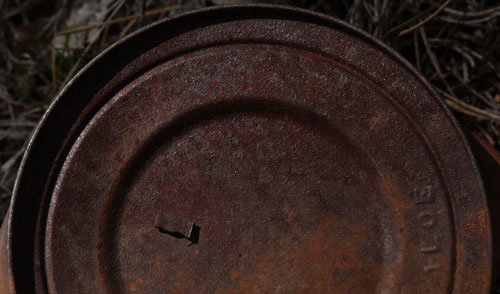
Can with Key Detatched - 1LOE
|
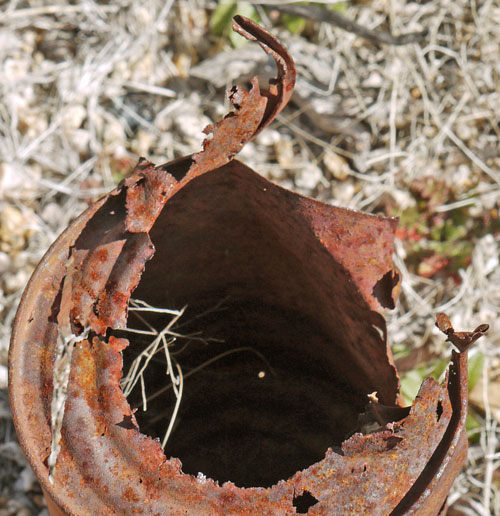
Un Crimped Can
|
|
The edges are very irregular, and the lid has been uncrimped from the cylinder. I'm guessing this was opened by chisel or pliers, etcetera.
|
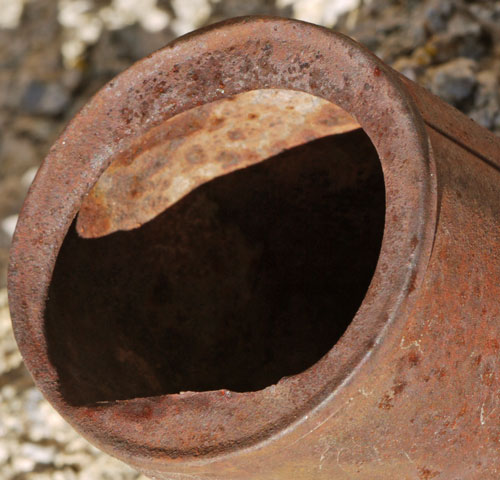
Down Rolled Edges
|
|
¾ of the circumference of the edge is neatly rolled down, and of a tidy round shape, but not concentric with the can. I think a curved blade was forced down into the can, leaving a flap opening. The flap was bent repeatedly until it snapped off.
|

Inside of Can Stamped ORN
|

Outside of Can Stamped ORN
|
|
Note 3 types of opener, Something like a nail, Something like tube piercing, and Something ratcheting around the edge.
|

Can with Nail Opening and Flap Opening |
|
Note nail vent flaps are pushed to the side, probably after can opening as they lie nearly flat on the lid. Note both edges of large flap opening are downrolled. Perhaps the opener was a diagonally cut and sharpened tube pounded or pressed through the lid.
|
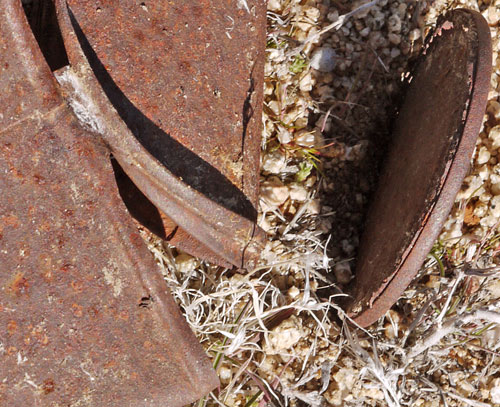
Cans Opened Under Rim
|
|
These two cans were cut through the cylinder rather than the flat lid. I don't see this often. In modern usage, I think this type of opener is available as a special tool to open metal cannister oil filters so the paper filter element and captured dirt can be examined. Otherwise I can't imagine why someone would prefer this and I've never seen this type of opener. Like with the key and strip openers, this leaves a sharp end on a cylinder that can stand up and be stepped on or fallen on. Although a modern can end has a wicked edge, the edge lies flat on the ground if dropped, and is safer.
|
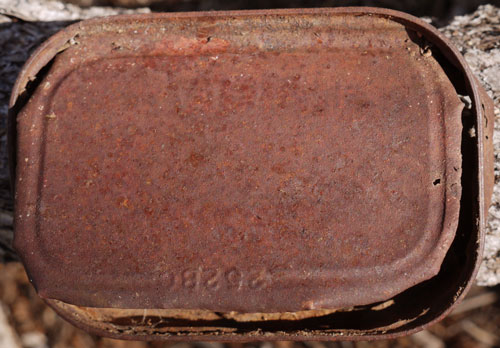
Fish Can - 252B0
Paint Barely Visible and Illegible
|
Self Closing Cans
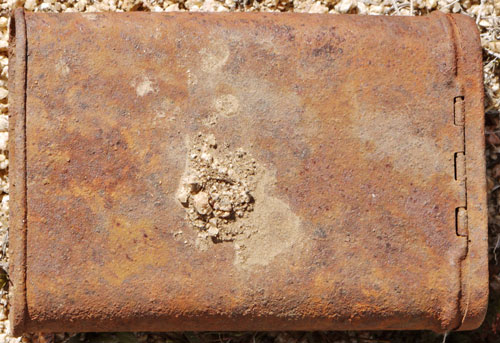
Hinged Can
|
|
In the 1970s, hand sized steel rectangular hinged cans like this were commonly used for bandages, expensive cigarettes, little kits of parts, etcetera. The steel was ink printed rather than using paper labels. By the end of the 70s, most such cans had gone to plastic.
|
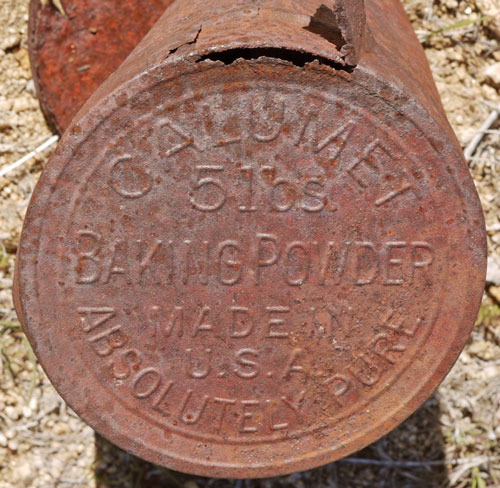
CALUMET
5lbs.
BAKING POWDER
MADE IN U.S.A.
ABSOLUTELY PURE
|
|
The lid slips tightly over the can. This can type is still commonly used for expensive cookies and antique looking storage cans
|
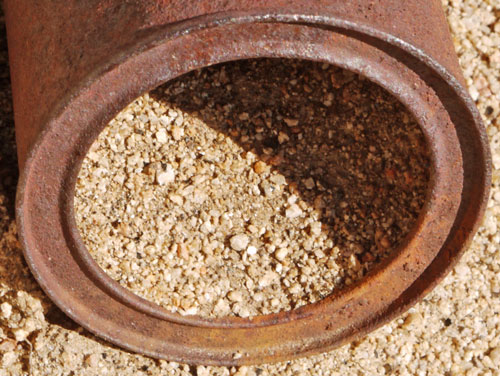
Closeable Can
|
|
This type of can is still used for baking powder. A steel lid pushes down into the hole.
|
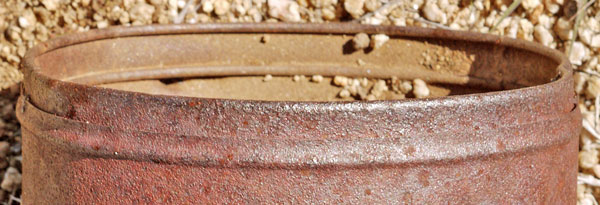
Closeable Can
|
|
When new, this can had a strip and key opening to separate the can from the lid. Once first opened, the can could be closed by pushing the lid over the ring with the two rolled beads. The lid edge and can edge would be sharp, so there is probably not a modern version.
|
Beverage Cans
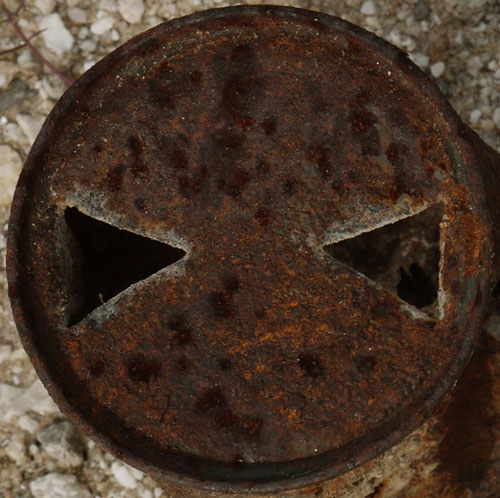
Steel Beverage Can
|
|
Through the 1950s, discarded beverage cans looked like this. Beer cans had similar shapes and sizes to today's aluminum beer cans. Shorter, squatter cans, or cans similar to today's canned juices are probably juice. Soda often came in stout recyclable glass crown sealed bottles. I don't find many steel soda cans. This can is opened using the piercing tool of a church key type opener. Usually, two opposite holes were opened so the beverage would not come out in glugs, but flow smoothly.
Church key openers usually have two of several types of tools to open cans and bottle. There are many theories as to why they are called church keys. I think it is because the loop type tool to open crowns of glass beverage bottles looks like the key ring end of an antique key.
|

Thermos Top, Threads
|

Thermos Bottom, Embossed Text
REPLACEMENT
PARTS
CUP 22A63
STOPPER 732
FILLER 227
THERMOS DIVISION-KING-SEELEY KSI THERMOS CO NORWICK ????
|
|
Air and Oil Filters and Thermos Bottles are two examples of things that are manufactured partly like a tin can and look sort of like a rusty can when found. But they are a little more expensive and may have lots of embossed text and logos, plus extra attached parts.
|
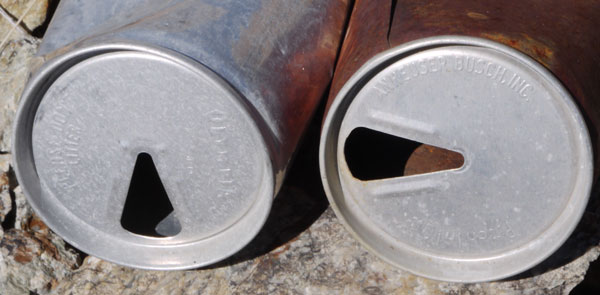
Pop Top, Ring Pull, Pull Tab Cans
Please Do Not Litter Olympia ---
Anheuser Busch, Inc. Pitch In!
|
|
In 1959, two radical changes were introduced to beverage cans. Adolph Coors introduced a completely aluminum, recyclable 7 ounce can. And Ermal Fraze invented the pull top can end. Part of the can end was scored thin so it would pull out easily, and a handle was attached.
To the right is a Budweiser steel can with aluminum top. Steel is much cheaper than aluminum, and steel can manufacturing was very common, so the bottom and sides remained steel for most beverage cans for many years. Note that there is an open seam on the wall of the steel can, as well as a seam at the can bottom: both seams cost something to manufacture.
The Olympia can on the left has an aluminum wall and bottom which is very thin and drawn without seams, thus reducing the cost of the aluminum can. Since it is all aluminum, it is easy to recycle, whereas it is expensive with the can on the right to separate steel from aluminum.
Beverage pop tops have almost always been aluminum. The same scored pull out design in steel has never become popular for beverages. Some steel juice cans today have a very tough sticker glued to the top which is pulled off to open, but they don't seem to be used in carbonated beverages like beer or soda. Many aluminum refining plants were built to supply the aircraft industry during WWII. There was massive over capacity in the aluminum industry into the 1980s, and aluminum companies helped pay for the development of products that would use industrial quantities of aluminum. This may be why drawn cans and pop tops for beverages are almost always aluminum. Drawn steel cans and steel pull out tops are common in food cans.
|
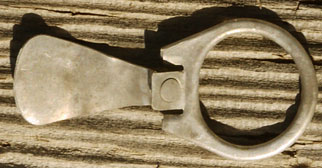
This is the tab pulled out of the can. It's too small to keep track of and too sharp to put in your pocket, so people just flung them whereever they opened a beer. They were sharp, and a danger to anyone walking or swimming barefoot. And they were aluminum, so they might take hundreds of years to corrode away. They stay a bright silver color, so they were always ugly against the dirt. At any good view, fishing spot, or other popular outdoor place, there would be hundreds in sight. Bottle crowns too.
Sometime in the 1970s, an anti litterbug revolution happened. Maybe what people had discarded freely before was biodegradable and never accumulated, and that's why people hadn't thought about it. But as a kid in the early 70's, I remember that at every corner in the Ocean Beach business district, cigarette butts, pop tops, and etcetera filled the gutter 8" deep and two feet out. Tossing things as you walked along was common and accepted. But the trash was no longer biodegradable, and it accumulated and blighted everywhere. Litterbug laws and no glass at the beach laws started to be passed and enforced. The pull tab litter problem had to be addressed.
Some people dropped the pull tab into the can, but it might come out and be swallowed or cut the tongue while drinking. A better solution was needed.
|
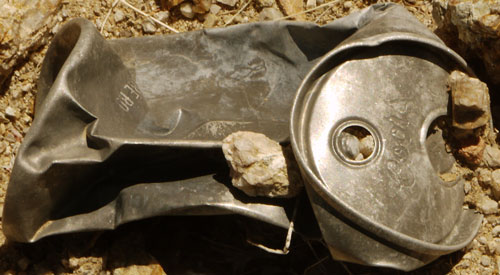
Coors Push Tab Can
|
|
This design was used mostly by Coors in the mid 1970s. You pushed down the big drinking hole and the little vent hole with your thumb. Each stayed attached inside the can as a flap. An uncommon problem was that you might cut your thumb.
|
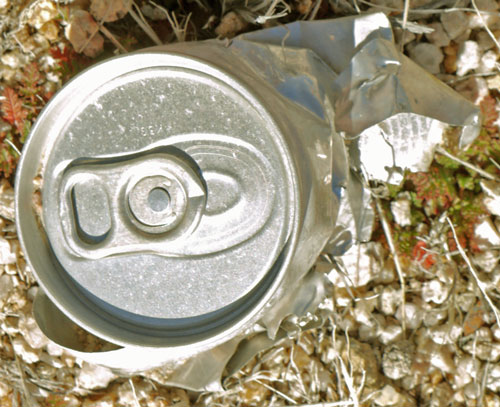
Stay Tab Can
|
|
Later in the 1970s Daniel F. Cudzik invented the Stay-Tab. It too incorporated a pop in section retained as a flap. A lever that pushed in the flap is riveted to the can top. The geometry has improved to open the flap wider and with better reliability, but the basic design is still used today.
This can has been opened by firearm rather than the tab. Mining and cow camp middens usually don't include bullet riddled cans. Historic mining equipment is easier for drunken morons to hit, and is not hauled away because it still tells the history of the site. Target practice on federal lands is better regulated and enforced, with certain areas posted for no shooting or hunting only shooting, and most other areas posted and enforced that shooters must pick up and remove all brass and target debris. Most if not all of the cans on this page are protected by federal antiquities laws - Please don't take them or vandalize them.
|

Aluminum - Steel Hybrid Pop Top
|
|
A less common example of a steel beverage can with an Aluminum Pop Top.
|
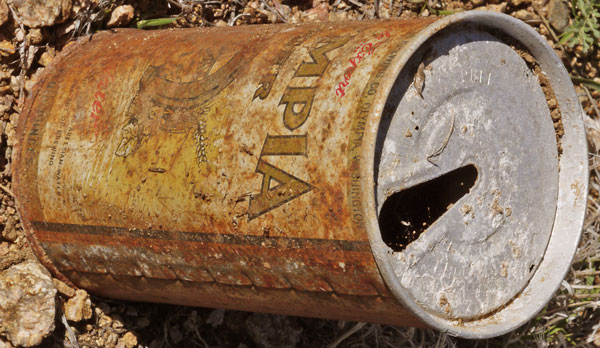
Olympia Aluminum - Steel Hybrid Pop Top Can
|
|
The next several pictures show that the text, end geometry, and hole geometry vary considerably. Close examination might narrow down the production year and brand.
|
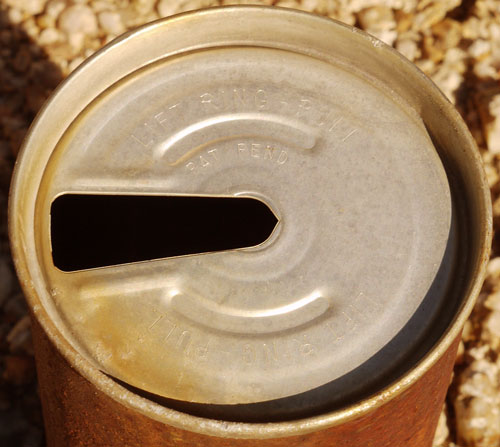
Aluminum - Steel Hybrid Pop Top Can
LIFT RING - PULL LIFT RING - PULL PAT PEND
|
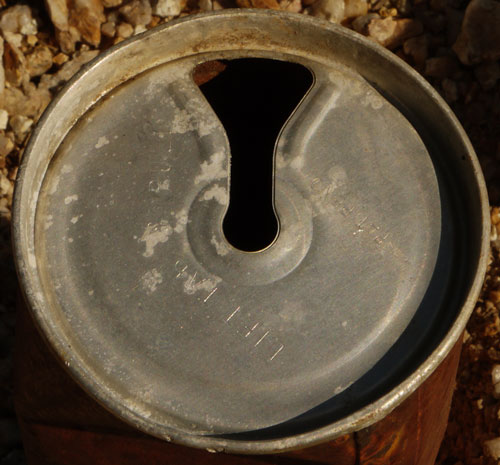
Budweiser Aluminum - Steel Hybrid Pop Top Can
LIFT TAB & PULL PAT PEND
Above and Below - Top and side views of one Budweiser can.
|
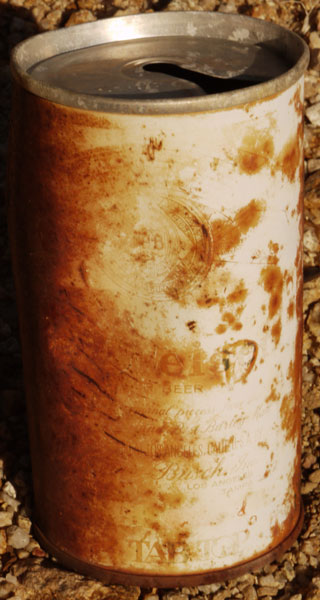
Budweiser Aluminum - Steel Hybrid Pop Top Can
|
A Book on Cans
A Jim Rock published Tin Canisters: Their Identification 1988, perhaps 1988a or 1988b, through the Klamath National Forest, USFS. I have not found a digital copy on line, but there may be a paper copy at Northern Arizona University Library. Southern Oregon University has a digital archive of his photos, but it is not oganized to be read through. Jim's work appears to be the best source of further information.
Can Openers
P-38 and P-51 are the numbers of the k ration military style modern cut downward lever style openers. The numbers refer to the length of the handle in millimeters.
|
A Rough Can Chronology from Internet Sources
|
|---|
| 1810 - 1820 |
The fill port had no vent. Some cans swelled or burst while cooking. |
| 1820 - WWI |
The fill port had a small central vent for cooking steam. |
| 1855 + |
Up Pushung Lever Type Can Openers |
| 1865 - |
Kerosene in tall rectagular small cap cans |
| 1875 - |
Tapered Cans |
| Mid 1870s - |
Machine Soldered Can Ends |
| - 1880s |
Hand Soldering. |
| 1883 + |
Tidy Machine Soldering of Side Seams |
| 1886 - Now |
Winding a key peels out a strip or the top.
Tapered Key Cans after 1895.
Coffee Cans after 1917. |
| 1897 - 1940s |
Log Cabin Shaped Syrup Cans, Modern Reproduction Runs |
| 1888 + |
Seam Crimping under Development |
| Late 1890s |
Double Lock Crimp Side Seams Inside or Outside of Caps |
| 1900 + |
Vent but no Fill Port. Most Evaporated Milk Cans after 1920. |
| 1904 + |
Modern Crimp and Sealant cans developed: "Sanitary Can" Company. |
| 1907 - |
Hinged Friction Closing Tobacco Cans |
| 1911 + |
Sanitary Cans dominate. |
| - 1930s |
Military and CCC Still Use Fill Port Cans |
| 1925 - |
Geared rotary can openers. |
| 1935 - |
Church Key can openers. |
| 1933 - |
Round Steel Quart Motor Oil Cans |
| 1935 - 1959 |
Crown Sealed Cone Top Beer Cans |
| 1945 - |
Aerosol Cans |
| 1953 - |
Soft Drinks Canned |
| 1959 - |
All Aluminum Church Key Beer Cans |
| 1962 - |
Pull Tab Beverage Cans |
| Mid 1970s |
Coors Push Tab |
| Late 70s |
Modern Stay Tab |
Glass
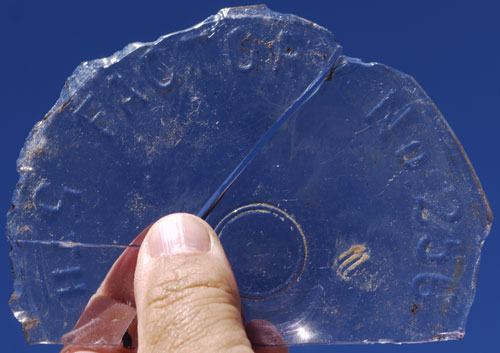
Glass Jug Bottom - 5th Factory No 256
|
|
Intact or even mostly intact glass is rare in middens - Too much recycling, shooting or collecting?
|
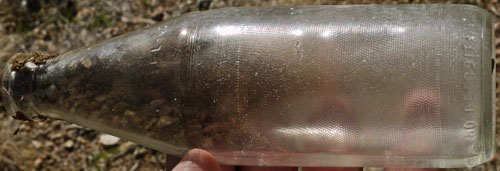
10 oz Beverage Crown Seal Type Bottle
|
 Bottom of the above intact beverage bottle.
Bottom of the above intact beverage bottle.
|
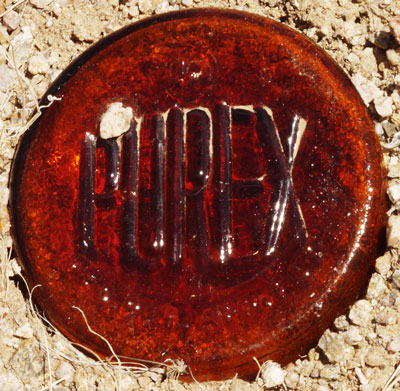
Purex Jug Bottom
|
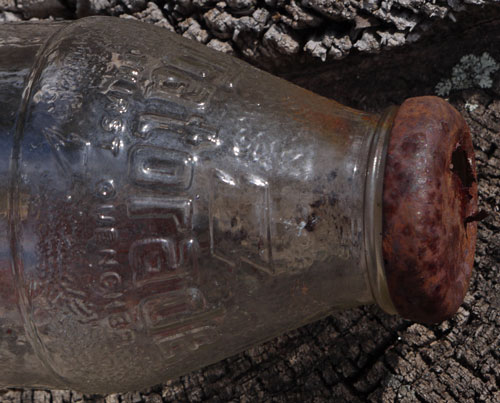
19 Ounce Glass Gatorade Bottle
I can't remember seeing glass Gatorade bottles.
|
Fronts of 3 Jars
Note that Jars do not have screw lids.

|
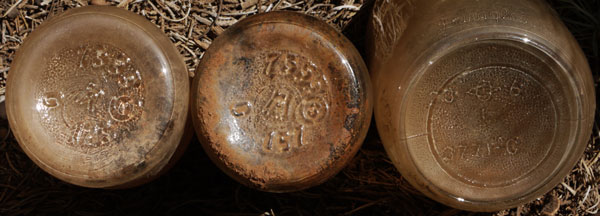
Bottoms of 3 Jars
7355
0
123 |
7355
0 S
157 |
Duraglas
S3 6
S771 C |
|
Other Refuse
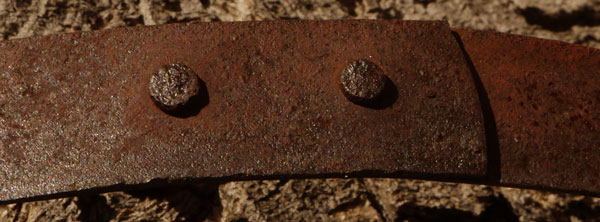
Barrel Hoop
|
|
This barrel hoop is shaped as the frustum of a cone.
|
Can Opening
| |
I took these pictures to show how different openers leave identifiable marks on cans.
|
| |
Lever Style Can Opener
|
Rotary Style Can Opener
|
Bottom
of Lid |

|
Top
of Lid |

|
Inside
of Can |

|
Outside
of Can |

|
| |
Lever Style Can Opener leaves a jagged edge,
ripped or scratched outside.
|
Rotary Style Can Opener leaves a smooth but wavy
edge, bite marks in crimped can end seam.
|
|
The 2 can openers shown directly below are the ones actually used to open the can shown above.
|

|
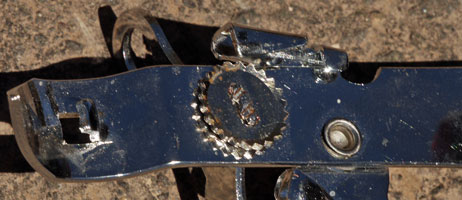
|

|
|
Left: Glass Bottle Crown Opener End Of 3 Function Can Opener
|
|
Center: Juice Can Piercer and Rotary Can Opener
|
|
Right: Victorinox Swiss Army Knife Lever Type Can Opener
|
|
The 2 additional can lever type openers shown below have very different geometries and would leave fairly unique marks on cans.
|
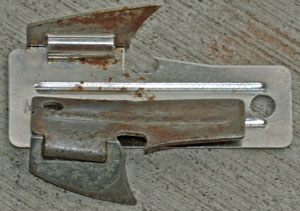
P38 and P51 Openers
|

Leatherman Pocket Knife
Lever Can Opener
|
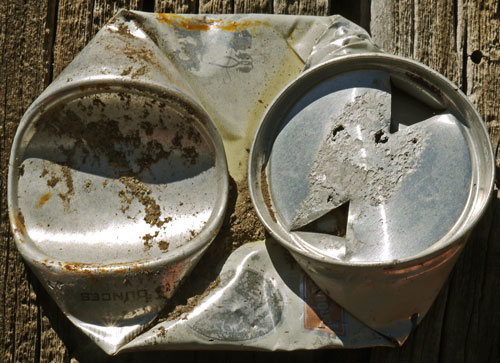
Coors Aluminum Can Opened by Churchkey - Before Pull Tabs
|

Opened by a Curved Church Key - Rare
|

Upper Fill Lid Embossed
|
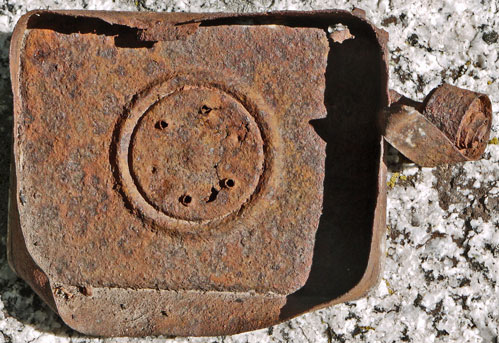
Lower Fill Lid Steam Holes
|
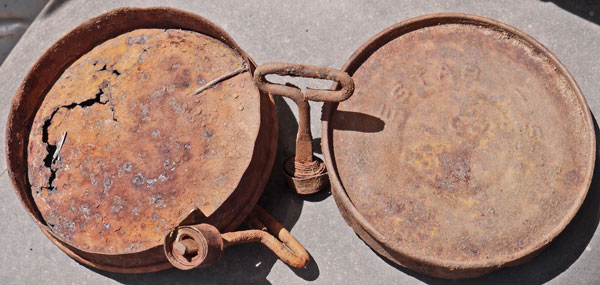
Self Opening Cans With Key Peeled Strip
|
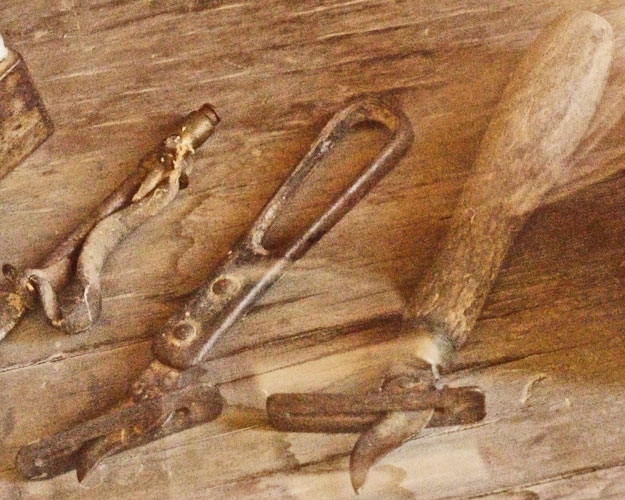
Can Openers? Laws Museum, Bishop
|
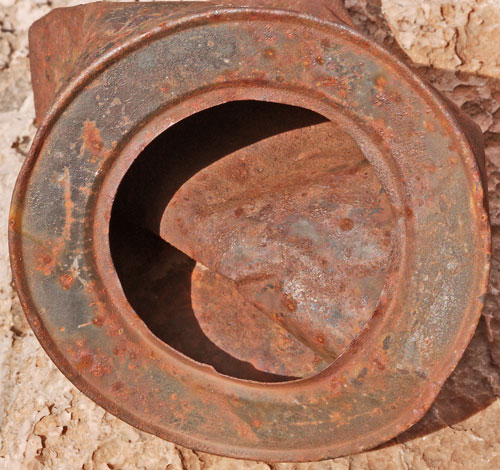
At the Grandview Mine, Solder is Dissolved Away on Some Cans, Allowing Examination of Each Piece Part.
|

Pull Tab - Spitz
|
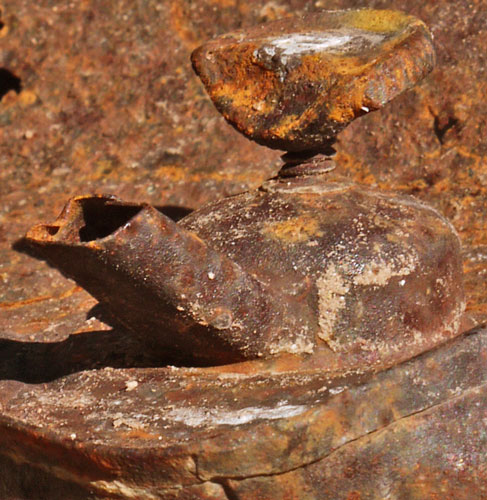
Valve Spout Detail
|


















































 Bottom of the above intact beverage bottle.
Bottom of the above intact beverage bottle.






















